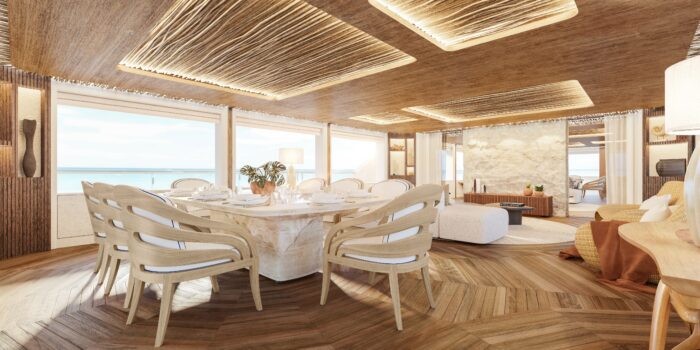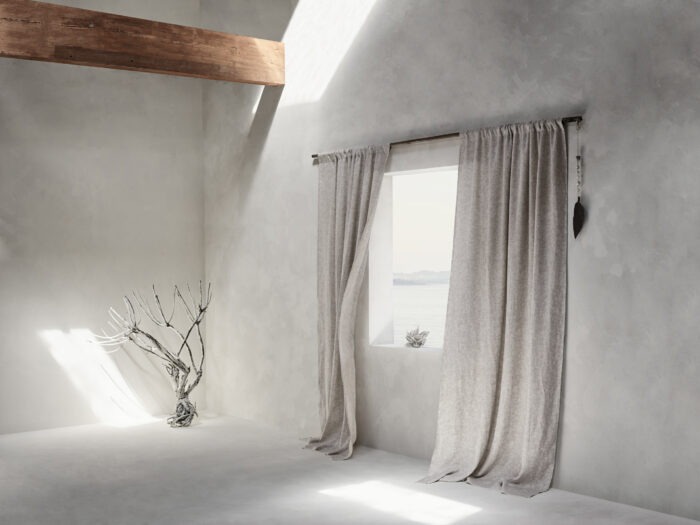Waves of change
Departing from the traditional, and occasionally unethical materials that can feature amongst a yacht’s interior finishes, yacht owners are increasingly looking for more sustainable solutions.

The last decade has seen a marked change in the interior design of superyachts. Departing from the traditional, and occasionally even unethical materials previously used for a yacht’s interior finishes, yacht owners are increasingly looking for sustainable designs, and giving their most prized possession the ‘green-credentials’ it deserves.
Partly thanks to new breakthrough technologies and materials, partly because of the changing demographic of the owners who commission them, and partly because of the designers and naval architects who conjure them, the yachting industry is now slowly navigating its way into greener waters.
For many of us, environmental credentials are increasingly a priority, and this shift in priorities is also now reflected in superyacht design. From hydrogen and hybrid power to energy-efficient hull designs, it is the advancements in sustainable technologies and design that are potentially the most important developments in the yachting industry. Shipyards are combining greener propulsion and power generation with clever design, and green credentials are fast becoming imperative to the technical side of a successful yacht build. But what of the luxurious interiors, are these also getting greener?
A number of leading interior designers are proving that sustainability and an award-winning interior need not be mutually exclusive. Leading the charge, Winch Design have been avoiding using anything endangered or rare for a number of years, and the studio even has a library dedicated to sustainable materials.
“Sustainability is increasingly taking centre stage across the whole industry, and each year becomes more and more important, not only for the planet but for the long-term success of the industry,” says Winch Design’s sustainability specialist, Alex Parkinson. “The majority of our clients want to enjoy responsible yachting, and, while there is still a long way to go with regards to environmental considerations, we are certainly seeing a more conscious effort from both designers and clients alike, ranging from the selection of materials to the choice of propulsion.”
Of course, eco-conscious owners don’t want to compromise on quality, and in the main they still expect the luxury finish with which superyachts are associated. It is therefore up to the designer to source sustainable materials that offer the best of both worlds. “We are privileged to work with an incredible variety of suppliers, whose passion to create a more conscious luxury is as strong as our own. Within the studio we have a huge library of materials for designers to experiment with, and that is constantly updated with visits from new or existing suppliers,” says Alex. “The innovation shown within sustainable materials is inspiring and really encouraging for us as designers.” Alternatives include natural by-products like fruit leaves, eggshells, and feathers, or commonplace materials, often recycled from the fishing or farming industry and then transformed into a luxury material. “We recently revealed a unique concept interior for the Amels 60 range, BAREFOOT. The yacht has an inviting and tactile colour palette, complimented by a variety of sustainable textures,” explains Alex. “Pineapple leaves for example have undergone a non-chemical hardening process, resulting in a lightweight, versatile and hard-wearing leather alternative, and adding subtle texture to wall panelling, as well as a great anecdote for the owner to tell their friends on a tour.”

Building on the idea of a circular economy is nothing new, but until recently many synthetic alternatives have generally been disregarded due to their sub-standard finish. However, suppliers are now producing synthetic alternatives that can be used to create high quality products with a finish that can be as luxurious, if not more so, as its natural counterpart. Synthetic, man-made alternatives for precious commodities such as teak are just one example. Dickie Bannenberg, from leading design studio Bannenberg & Rowell Design, says that it is becoming harder and harder to secure the quality and size of teak that the industry used to take for granted. “Our recent 55.5m (182ft) MOON SAND, built by Lürssen, has entirely artificial teak exterior decks,” says Dickie. “And I can only see the supply of natural materials, such as teak, going in one direction, and as such these synthetic alternatives are the way forward.”
Aside from replacing rare natural materials, synthetic alternatives can also be formed by recycling and upcycling waste that would otherwise be polluting the earth. Favoured by leading design studio Harrison Eidsgaard, Sylka’s sustainable range uses plastic waste to produce high quality fabrics. “Their soft and durable carpets are created from plastic bottles gathered in the oceans, and they are rolling out a program of recycling old or unwanted carpets,” says Ewa Eidsgaard, Director at Harrison Eidsgaard. The notion of a sustainable, circular economy is certainly making its way into the yachting arena.
Another studio at the top of their game in responsible design is Design Unlimited. Working with the marine adventure company Arksen, the studio helped create the sustainable interior for the builder’s latest launch, the Arksen 85. “Arken’s builds are designed with ecological integrity,” says Managing Director Julie Tucker. “Many of the interior materials are recyclable, and the modular cabin system allows for design evolution and adaptation even during its usage.”
However, eco-conscious design is not just about using sustainable materials; to be truly green they also need to be ethically sourced. Harrison Eidsgaard specifies green credentials for the materials they use in all of their projects, but the main focus is on ethically sourced, natural materials. “Ideally these will be organic and sustainable,” says Ewa. “All of our linens, cottons and wools are sourced responsibly, and many of our clients do request information about their origin.” de Le Cuona is just one of the suppliers that Harrison Eidsgaard work with, and their collections include certified organic fabrics designed with sustainability, wellness and health in mind. “It is important that our organic textiles are certified to make sure the products have been through the rigorous certification process,” says Bernie de Le Cuona, CEO, de Le Cuona. “Each stage is traceable from the field to fabric and even the warehouse is certified to GOTS. Pure has been designed without compromise on the beauty and the handle of the fabrics – a first for the industry and a game changer for sustainable luxury in interiors.” And it doesn’t stop there. “Their ethos extends throughout the full supply chain – from packaging to sample recycling, and carbon neutral shipping,” says Ewa.

Nature Squared is another leading supplier of sustainable materials, which can be used to create stunning superyacht interiors (and cars, jets and homes). Where possible, they source farmed or waste materials that can be harvested in a way that supports local economies in developing countries. Fostering local knowledge and materials with their own skills and experience, Nature Squared takes what might otherwise become waste or landfill and turns it into something beautiful and luxurious, while at the same time providing sustainable employment and encouraging traditional skills that go back centuries. “We believe in simultaneously addressing both environmental and social issues. By enhancing heritage craft and applying it to waste materials, we reduce methane production, restore pride in local traditions and create an innovative, design-led thinking that will remain relevant for future generations,” says Lay Koon Tan, Co-Founder of Nature Squared.

All of the above are not just fashionable trends that will go out of style, but positive design improvements that make for more sustainable designs with each passing year. As innovative materials are invented and technical challenges overcome, design boundaries are pushed, and these will continue to be driven further as more owners give designers the push to be greener. Of course, there are always pressures on producing high-quality alternatives, and these directly bear on what is ultimately achievable in the interior design of the yacht. But this is where good designers come into their own, paving the way for a more eco-conscious luxury within the interior design of superyachts. The ecological tide is definitely turning.
Related News





 Previous Article
Previous Article